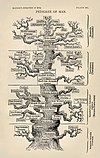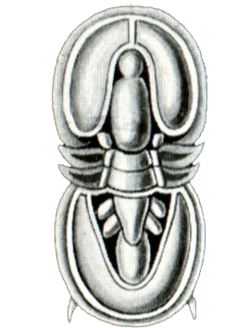User:Abyssal/Portal:Ediacaran
IntroductionSelected article on the Ediacaran world and its legacies
The evolutionary history of life on Earth traces the processes by which living and fossil organisms have evolved since life on the planet first originated until the present day. Earth formed about 4.5 Ga (billion years ago) and life appeared on its surface within one billion years. Microbial mats of coexisting bacteria and archaea were the dominant form of life in the early Archean. The evolution of oxygenic photosynthesis, around 3.5 Ga, eventually led to the oxygenation of the atmosphere, beginning around 2.4 Ga. The earliest evidence of eukaryotes (complex cells with organelles), dates from 1.85 Ga, and while they may have been present earlier, their diversification accelerated when they started using oxygen in their metabolism. Later, around 1.7 Ga, multicellular organisms began to appear, with differentiated cells performing specialised functions.
The earliest land plants date back to around 450 Ma (million years ago), although evidence suggests that algal scum formed on the land as early as 1.2 Ga. Land plants were so successful that they are thought to have contributed to the late Devonian extinction event. Invertebrate animals appear during the Vendian period, while vertebrates originated about525 Ma during the Cambrian explosion. During the Permian period, synapsids, including the ancestors of mammals, dominated the land, but the Permian–Triassic extinction event251 Ma came close to wiping out all complex life. (see more...) Selected article on the Ediacaran in human science, culture and economics In 1858, Charles Darwin and Alfred Russel Wallace published a new evolutionary theory that was explained in detail in Darwin's On the Origin of Species (1859). Unlike Lamarck, Darwin proposedcommon descent and a branching tree of life. The theory was based on the idea of natural selection, and it synthesized a broad range of evidence from animal husbandry, biogeography, geology, morphology, and embryology. The debate over Darwin's work led to the rapid acceptance of the general concept of evolution, but the specific mechanism he proposed, natural selection, was not widely accepted until it was revived by developments in biology that occurred during the 1920s through the 1940s. Before that time most biologists argued that other factors were responsible for evolution. The synthesis of natural selection with Mendelian genetics during the 1920s and 1930s founded the new discipline of population genetics. Throughout the 1930s and 1940s, population genetics became integrated with other biological fields, resulting in a widely applicable theory of evolution that encompassed much of biology—the modern evolutionary synthesis. (see more...) Selected image
Did you know?
GeochronologySeries - Terreneuvian - Cambrian Series 2 - Cambrian Series 3 - Furongian Geography - Pannotia - Baltica - Gondwanaland - Laurentia - Siberia Fossil sites - Walcott Quarry Researchers - Stephen Jay Gould - Simon Conway Morris - Charles Doolittle Walcott Quality ContentFeatured Cambrian articles - None SubcategoriesRelated contentAssociated WikimediaThe following Wikimedia Foundation sister projects provide more on this subject:
|






















